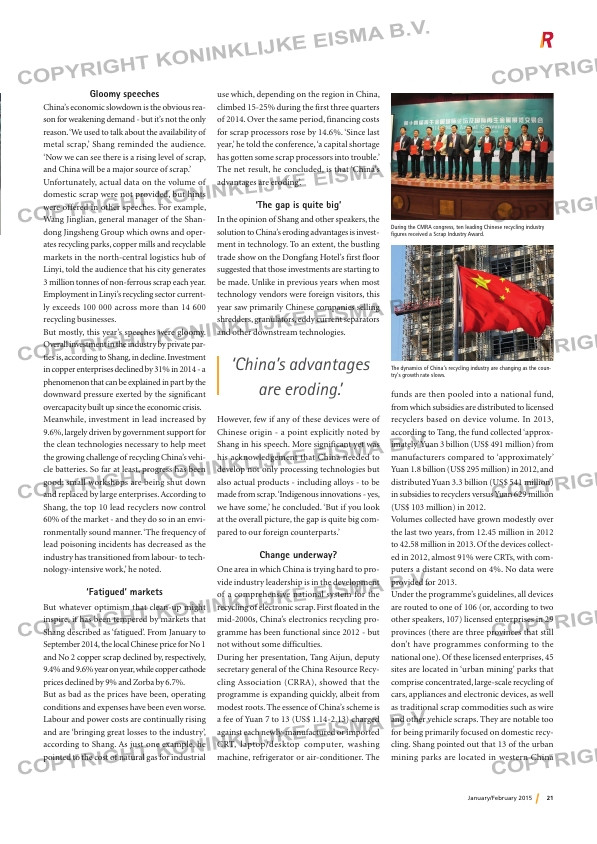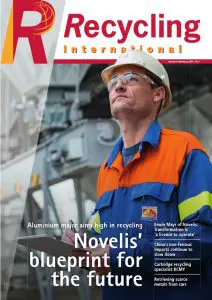Page 21 from: January / February 2015

21January/February 2015
Gloomy speeches
China’s economic slowdown is the obvious rea-
son for weakening demand – but it’s not the only
reason. ‘We used to talk about the availability of
metal scrap,’ Shang reminded the audience.
‘Now we can see there is a rising level of scrap,
and China will be a major source of scrap.’
Unfortunately, actual data on the volume of
domestic scrap were not provided, but hints
were offered in other speeches. For example,
Wang Jinglian, general manager of the Shan-
dong Jingsheng Group which owns and oper-
ates recycling parks, copper mills and recyclable
markets in the north-central logistics hub of
Linyi, told the audience that his city generates
3 million tonnes of non-ferrous scrap each year.
Employment in Linyi’s recycling sector current-
ly exceeds 100 000 across more than 14 600
recycling businesses.
But mostly, this year’s speeches were gloomy.
Overall investment in the industry by private par-
ties is, according to Shang, in decline. Investment
in copper enterprises declined by 31% in 2014 – a
phenomenon that can be explained in part by the
downward pressure exerted by the significant
overcapacity built up since the economic crisis.
Meanwhile, investment in lead increased by
9.6%, largely driven by government support for
the clean technologies necessary to help meet
the growing challenge of recycling China’s vehi-
cle batteries. So far at least, progress has been
good: small workshops are being shut down
and replaced by large enterprises. According to
Shang, the top 10 lead recyclers now control
60% of the market – and they do so in an envi-
ronmentally sound manner. ‘The frequency of
lead poisoning incidents has decreased as the
industry has transitioned from labour- to tech-
nology-intensive work,’ he noted.
‘Fatigued’ markets
But whatever optimism that clean-up might
inspire, it has been tempered by markets that
Shang described as ‘fatigued’. From January to
September 2014, the local Chinese price for No 1
and No 2 copper scrap declined by, respectively,
9.4% and 9.6% year on year, while copper cathode
prices declined by 9% and Zorba by 6.7%.
But as bad as the prices have been, operating
conditions and expenses have been even worse.
Labour and power costs are continually rising
and are ‘bringing great losses to the industry’,
according to Shang. As just one example, he
pointed to the cost of natural gas for industrial
use which, depending on the region in China,
climbed 15-25% during the first three quarters
of 2014. Over the same period, financing costs
for scrap processors rose by 14.6%. ‘Since last
year,’ he told the conference, ‘a capital shortage
has gotten some scrap processors into trouble.’
The net result, he concluded, is that ‘China’s
advantages are eroding’.
‘The gap is quite big’
In the opinion of Shang and other speakers, the
solution to China’s eroding advantages is invest-
ment in technology. To an extent, the bustling
trade show on the Dongfang Hotel’s first floor
suggested that those investments are starting to
be made. Unlike in previous years when most
technology vendors were foreign visitors, this
year saw primarily Chinese companies selling
shredders, granulators, eddy current separators
and other downstream technologies.
However, few if any of these devices were of
Chinese origin – a point explicitly noted by
Shang in his speech. More significant yet was
his acknowledgement that China needed to
develop not only processing technologies but
also actual products – including alloys – to be
made from scrap. ‘Indigenous innovations – yes,
we have some,’ he concluded. ‘But if you look
at the overall picture, the gap is quite big com-
pared to our foreign counterparts.’
Change underway?
One area in which China is trying hard to pro-
vide industry leadership is in the development
of a comprehensive national system for the
recycling of electronic scrap. First floated in the
mid-2000s, China’s electronics recycling pro-
gramme has been functional since 2012 – but
not without some difficulties.
During her presentation, Tang Aijun, deputy
secretary general of the China Resource Recy-
cling Association (CRRA), showed that the
programme is expanding quickly, albeit from
modest roots. The essence of China’s scheme is
a fee of Yuan 7 to 13 (US$ 1.14-2.13) charged
against each newly-manufactured or imported
CRT, laptop/desktop computer, washing
machine, refrigerator or air-conditioner. The
funds are then pooled into a national fund,
from which subsidies are distributed to licensed
recyclers based on device volume. In 2013,
according to Tang, the fund collected ‘approx-
imately’ Yuan 3 billion (US$ 491 million) from
manufacturers compared to ‘approximately’
Yuan 1.8 billion (US$ 295 million) in 2012, and
distributed Yuan 3.3 billion (US$ 541 million)
in subsidies to recyclers versus Yuan 629 million
(US$ 103 million) in 2012.
Volumes collected have grown modestly over
the last two years, from 12.45 million in 2012
to 42.58 million in 2013. Of the devices collect-
ed in 2012, almost 91% were CRTs, with com-
puters a distant second on 4%. No data were
provided for 2013.
Under the programme’s guidelines, all devices
are routed to one of 106 (or, according to two
other speakers, 107) licensed enterprises in 29
provinces (there are three provinces that still
don’t have programmes conforming to the
national one). Of these licensed enterprises, 45
sites are located in ‘urban mining’ parks that
comprise concentrated, large-scale recycling of
cars, appliances and electronic devices, as well
as traditional scrap commodities such as wire
and other vehicle scraps. They are notable too
for being primarily focused on domestic recy-
cling. Shang pointed out that 13 of the urban
mining parks are located in western China
The dynamics of China’s recycling industry are changing as the coun-
try’s growth rate slows.
During the CMRA congress, ten leading Chinese recycling industry
figures received a Scrap Industry Award.
‘China’s advantages
are eroding.’
RI1-CMRA.indd 21 21-01-15 15:07



